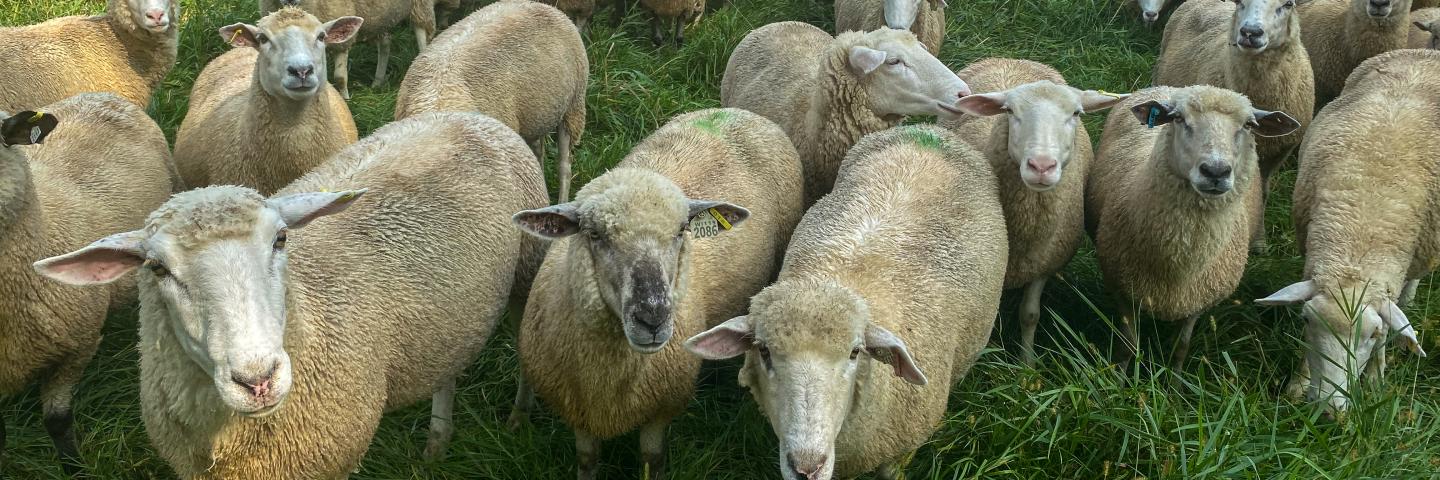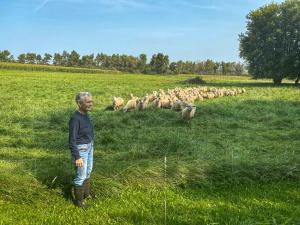Green Pastures Give Back

The Environmental Quality Incentives Program gave distinguished sheep grazer and grazing mentor, Barbara Salas, the resources to manage her land in a way that allows both agricultural production and wildlife diversity to coexist and thrive.
Background
For over 20 years, Barbara Salas of Dodge County, Wisconsin has independently managed a grass-fed lamb operation. A distinguished sheep grazer and conservationist, Barbara prides herself on managing her land in a way that allows both agricultural production and wildlife diversity to coexist and thrive. Barbara grew up in Milwaukee and discovered her passion for wildlife and livestock at her uncle’s farm. Later in life, she bought a 72-acre farm in Burnett, Wisconsin where she started her business, Salas Farms Grass Fed Lambs, and began her journey in stewarding the land through green pastures.
For the first 15 years, Barbara rented out her land for row cropping and her grazing operation began small with only four sheep. Then, with the assistance received through the U. S. Department of Agriculture Natural Resources Conservation Service (NRCS), she was able to make substantial strides in expanding her operation. This expansion not only benefited the local wildlife and other natural resources in her area, but it helped transform her pastures into a lush green landscape for her grazing operation of 100 ewes.
Highlights
In 2009, Barbara applied for her first NRCS financial assistance program and was awarded a contract through the Environmental Quality Incentives Program (EQIP) for 8 acres of prescribed grazing. In 2013 and 2015, she received EQIP funding for 27 acres of forage and biomass planting, 3 miles of fencing, 1.5 miles of livestock pipeline, and an additional 50 acres of prescribed grazing.

Along with NRCS, the Wisconsin Department of Agriculture, Trade and Consumer Protection (DATCP) and other local partners were able to provide Barbara with the knowledge and resources needed, to ensure her new operation was established correctly. According to Barbara, the technical and financial assistance provided by NRCS has played a pivotal role in the successful conversion of her land to pasture. The Salas Farm continues to be a thriving, regenerative agricultural operation that gives back to the land. In transitioning the land to permanent grass and implementing a prescribed grazing plan, Barbara has made tremendous efforts to protect water quality, enhance soil health, reduce soil erosion, improve plant productivity, and expand wildlife habitat.
Barbara is now able to serve her community by mentoring other beginning grazers and opening her property to NRCS staff and the public for learning opportunities. “Barbara has been great to work with over the years. I am aware of quite a few landowners whom she has provided pointers and suggestions, based on her experiences to help grazers along the way,” said Cory Drummond, NRCS District Conservationist at the Juneau Service Center, “She has been both an ambassador for conservation and mentor for local grazers.”
Future Plans
Through the NRCS Conservation Stewardship Program (CSP), Barbara has plans to expand on her conservation efforts by installing a native prairie planting to benefit pollinators and committing to a multi-year project to control invasive plants like wild parsnip, using prescribed grazing. With retirement on the horizon, Barbara remains dedicated to her flock and grazing journey. Reflecting on the past 22 years, Barbara’s words tell a story of unwavering determination and fulfillment, “every single bit of it has been worth it. It’s what I've always wanted to do.”
Additional Information
Environmental Quality Incentives Program - Wisconsin
The Environmental Quality Incentives Program (EQIP) provides financial and technical assistance to agricultural producers and non-industrial forest managers to address natural resource concerns.
Learn More
